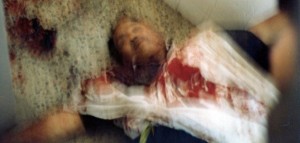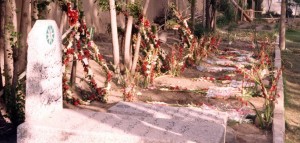Source: iranwire.com/features/6478/
Translation by Iran Press Watch

Aida Ghajar
Monday, September 1, 2014
Following the 1978 revolution and the rule of the clerics, opposition to Baha’is began in Iran. Arrests of members of local and National Spiritual Assemblies and the execution of many of them, demolition of sacred sites, destruction of cemeteries and search and ransacking of homes and houses indicated the continuous and systematic persecution of Baha’is in Iran. However, the torture and execution of seven Baha’is of Hamadan ̶ a city southwest of the capital ̶ remains untold.
Hussein Motlagh, Sohrab and Soheil Habibi, Hussein Khandel, Tarazollah Khozein, Nasir Vafaii, and Firoz Naeimi were seven Baha’is in Hamadan who were arrested for serving as members of the spiritual assembly of Hamadan; after many months of interrogation, incarceration and court sessions, they lost their lives under brutal and continuous torture. On the day following their execution, their bodies, with visible signs of torture, were found in front of the entrance of the Imam Khomeini Hospital that was located across from their prison. Ironically, three of the victims had been serving as physicians in that same hospital before their arrest.
Baha’i spiritual assemblies have 9 members. The other two members of Spiritual Assembly of Hamadan were Ms. Akhtar Naeimi and Ms. Batool Khozein, wives of two of the victims, who were repeatedly summoned to the Revolutionary Court of Hamadan and were constantly interrogated. Ms. Khozein passed away of old age later on in Iran, and Ms. Naeimi still resides in Hamadan.
Although the execution of these seven was reported in newspapers and television in Iran, there was no detailed media coverage of the event. After over thirty years since the executions, the families of the victims have handed manuscripts and various documents to Iran Wire ̶ documents that reveal details of the incident for the first time.
Hussein Motlagh, the secretary of the Spiritual Assembly of Hamadan, recalled his court session with his codefendants Sohrab and Soheil Habibi and Hussein Khandel in which, as the spokesperson, he defended against the charges imposed by the presiding judge, Abul-Hasan A’lami. Besides the judges in this distinguished court, the Assistant Prosecutors of the Revolutionary Court, Mr. Mosavi and Mr. Hashemi, and a representative of the Society for the Propagation of Islam (1) and Mr. Motlagh’s interrogator, Mr. Ebrahim Derafshi, were present.
“The court session started with greetings to Imam Khomeini and cursing of the hypocrites and enemies of the state. I did not observe any audio recording of the proceedings. Even, at times, I noticed that the court clerk was not taking notes”.
“Hiding documents”, “connection with SAVAK (secret police of the previous regime), Zionists and Imperialists”, “disturbing the minds of the public in general, and of Prime Minister [Mehdi] Bazargan (2), specifically”, “provoking Baha’is to lie and fake being oppressed”, and “sending money to Israel” were among the charges the defendants faced at court, none of which Mr. Motlagh accepted.
According to Mr. Motlagh’s notes, all the documents of the spiritual assembly “like all offices and businesses” was destroyed after the fifth year. Although the court was in possession of all the files of the assembly for the previous 5 years, “it was obvious from the questions that they had not studied them.” The charges of “collaboration with SAVAK” and being “agents of Zionism” were based on the petition which Baha’is had sent to SAVAK and the police force complaining about “abuse, harassment, and deprivation” they had faced. Mr. Motlagh, as the Corresponding Secretary of the Assembly, had written all the letters on behalf of that institution. He had telegraphed the petition to Mr. Bazargan, then Prime Minister of the Provisional Government. The court resolved that Mr. Bazargan’s future stances were affected after reading the petition: “After receiving your petition, Mr. Bazargan questioned the efficiency of the revolutionary committees and the legality of a multitude of independent centers of decision making”, the court concluded.

The charge of “collaboration with SAVAK” was denied by Mr. Motlagh. “All the letters referred to were written when I was not a member of the Assembly. By the time I became a member of the Assembly, SAVAK was about to dissolve; when I became the Corresponding Secretary it had already disbanded”, he stated in his notes.
Another charge of Mr. Motlagh was sending money abroad, specifically to Israel. “All the money our assembly received was contributions from Baha’is of Hamadan donated for specific purposes. Part of these contributions were earmarked for the National Assembly and a portion was allocated for the upkeep of Baha’i sacred places. How is it that followers of other religions may freely practice their right to make donations but Baha’is are deprived of this inherent right?” he responded. He also refuted the court documentation in regards to the charge of “provoking Baha’is to fake being oppressed” and called them “untrue”.
According to Mr. Motlagh’s notes, the court ended with Hojatoleslam Mosavi, one the judges present at the trial, telling him: “God willing, all the issues will be resolved soon”. Mr. A’lami, the religious judge, while leaving the court, told Mr. Motlagh: “Do you know why I prolonged these proceedings? I wanted to understand the truth so as to issue a just verdict”.

It is mentioned in the notes of the victims that two members of the National Spiritual Assembly of the Baha’is of Iran had attempted to meet with Ayatollah Mir Asadullah Madani, a member of the first Council of Experts ̶ an assembly of the top ruling clergy. “Initially, he refused to meet with them”; however, they eventually met with him. “For 136 years, you have been like a thorn in our eyes. Have you forgotten what you did to us at Fort Tabarsi?” he asked them.
Ayatolah Madani’s comment refers to a battle in 1849 between Mulla Husayn-i Bushru’i ̶ an early follower of Babism, the predeccessor religion to the Baha’i Faith ̶ with his opponents at Fort Tabarsi, Mazandaran, a province in north of Iran. According to historical accounts, although Mulla Husayn adhered to Islam, he believed that Mirza Ali Muhammad Shirazi (known as the “Bab”, or Gate) was the gate to the “Occulted Imam” (3).
“The Judgment Day We Saw with Our Own Eyes”
Bahireh Motlagh, the wife of Hussein Motlagh, is among the people providing Iran Wire with the hand written notes of the victims. According to these depositions, Judge A’lami had told the seven Baha’is: “Upon thoroughly investigating you, we could not find a flaw in you. Our intention is for you to accept Islam. Become Muslims and we will set you free”. In her opinion, the only crime of her husband and the other six Baha’is was their belief in their religion.
Mrs. Motlagh, along with the families of other victims, frequently had contacted the authorities inquiring about the status of their beloved seven. Ayatollahs A’lami and Hamidi, and Mr. Mokarram, representatives of Hamadan in the Iranian Parliament; Mr. Babazadeh, the Attorney General; and, Mr. Hussein Maleki, a representative of the President [Abolhasan] Banisadr’s office were among people addressed by the families of the victims.
In a book called “The Judgment Day We Saw with Our Own Eyes”, Bahireh has written about her memories of the time of her husband’s captivity. In an interview with Iran Wire, she portrayed “The Judgment Day” as follows: “Two days prior to the executions, the officers came to our homes to confiscate our property. We expected our husbands would be killed in the near future. We wrote a petition to Mr. A’lami. After delivering the letter to the guard, I went home and heard the phone ringing. All I could hear from the other side was the wailing and lamentation. I knew. I went to the home of one of the spouses of those loved ones. She was wearing a black dress. Shouting at her, I asked: why are you dressing up in black? What are you waiting for? Rush to the streets and cry for justice!”
Bahireh Motlagh and her 8-year-old daughter took a taxi and went to the hospital. As a result of her speeches and talks at the hospital and subsequently at the funeral, she was threatened and had to begin a life in hiding.
“You still are lamenting for Imam Hussein who was martyred 1400 years ago, heedless of the fact that you have now martyred thousands of Husseins! I raised my daughter’s hand and declared that she was like another Ali Asghar, the young child of Imam Hussein who was martyred with him in Karbila. You have delivered hundreds of thousands of Ali Asghars to our society!”
On the day following the funeral, the headlines of the media read: “seven Zionist spies and employees of the defunct SAVAK were shot in Hamadan”.
Among Mr. Motlagh’s writings was his will and testament, addressing his wife and children: “Everyone’s life will eventually come to an end. How sweet it is if this end is accompanied with honor, honesty and faith. At these last moments, I beg the almighty to grant you a heart filled with faith and kindness to each other and compassion towards all mankind. I am happy that my life had a good ending. Dear Bahireh, my only regret is that from this moment on you will endure the heavy burden of life alone. I will pray for those who unjustly ruled against me, and ardently wish that the truth would be revealed soon to all”.
Four months after she laid her husband to rest, Bahireh Motlagh left Iran via the border of Pakistan.
1. Anjuman-i Tablighat-i Islam. For a scholarly description of the complex infrastructure of anti-Baha’i organizations in Iran, see http://bahai-library.com/choubine_suppression_bahais_iran, in which there is reference to this partcular organization as follows:
“After the Islamic Revolution, a number of SAVAK’s secret documents were discovered. Mujadih Newspaper, in its 9 June 1980 issue, printed a facsimile of a document related to the year 1350 [1971], which is illuminating: “Regarding Anjuman Tablighat Islami [Society for the Promotion of Islam]. The supervisor of Anjuman Islami in the central office [Tehran?] has requested SAVAK to provide necessary aid in combating Bahá’ís scientifically and intellectually. In sharing this request of the Anjuman Islami with your contacts among known elements in the region, kindly emphasize that their activities should not cause provocation or interference. In simpler terms, while maintaining public order, Anjuman Tablighat Islami is permitted to use SAVAK’s assistance to combat the Bahá’ís.” The chief of SAVAK’s Third Department signed this document. Also, Subh-e Azadegan Newspaper, in its Bahman 1360 [February 1982] issue, in an article under the title “A Glance at the Anjuman Hojjatiyeh”, described at length the deep relationship between SAVAK and Anjuman Hojjatiyeh. For a more detailed discussion of the relationship between SAVAK and Anjuman Hojjatiyeh, see Hizb Qa’idin Zaman [The Party of Founders of Time], a title of Anjuman Hojjatiyeh, by `Amadu’d-Din Baghi.”
2. Mehdi Bazargan, at http://en.wikipedia.org/wiki/Mehdi_Bazargan
3. It’s complicated. See http://en.wikipedia.org/wiki/Battle_of_Fort_Tabarsi
Leave a Reply